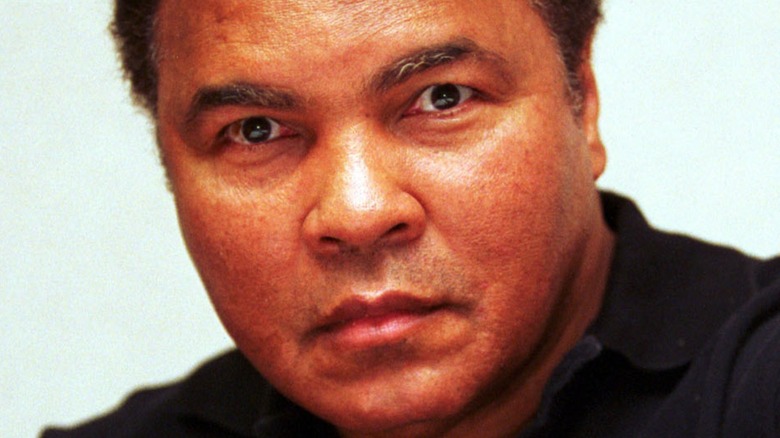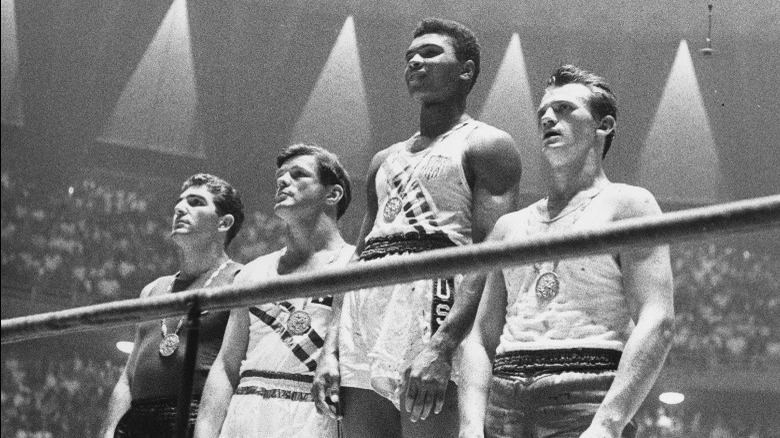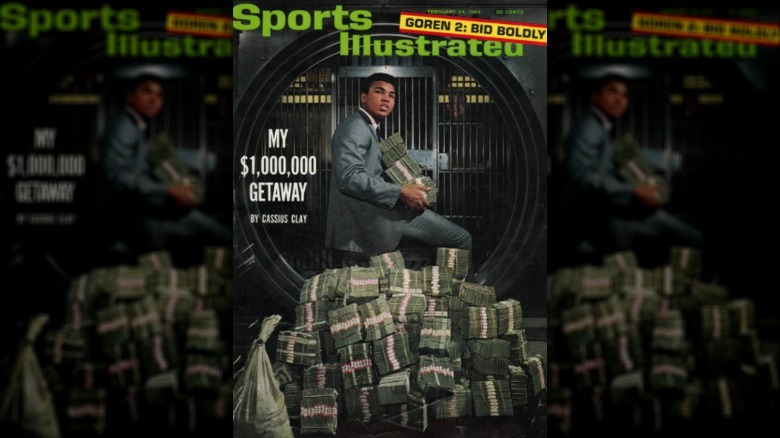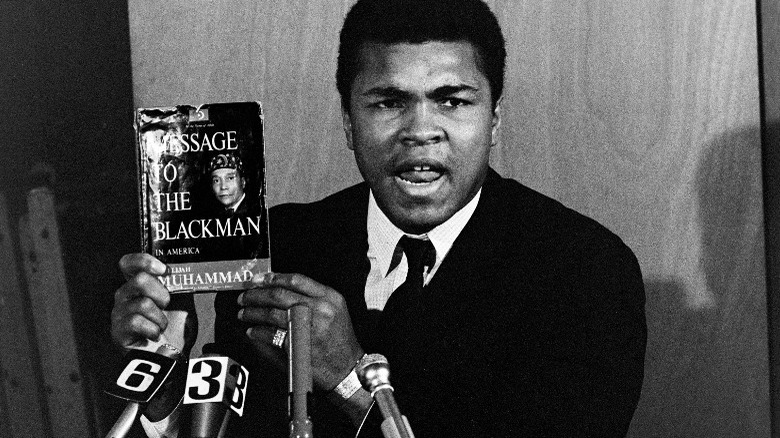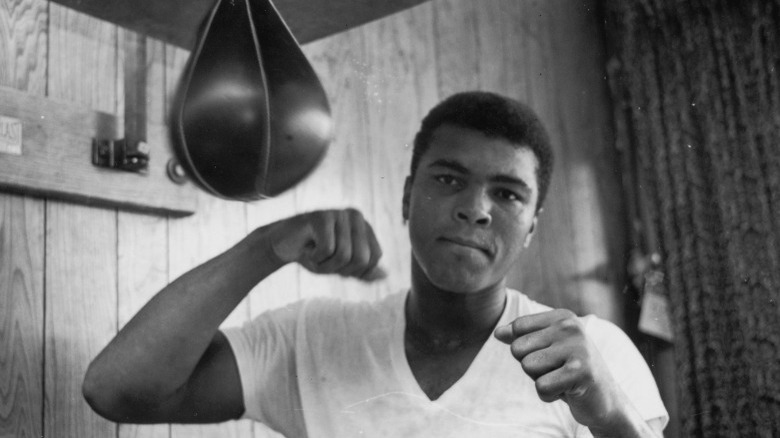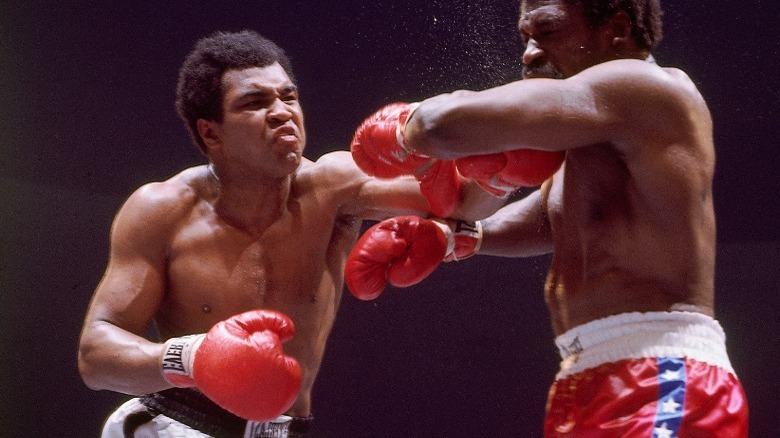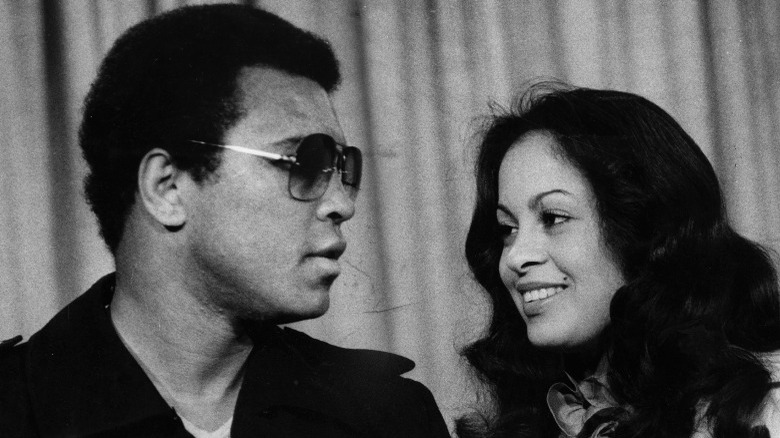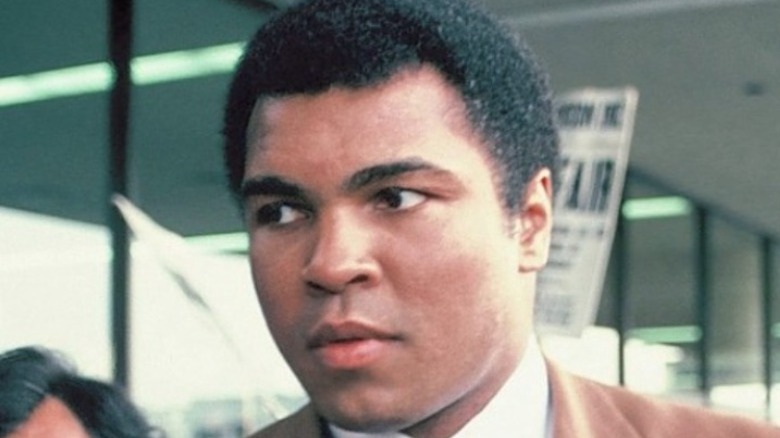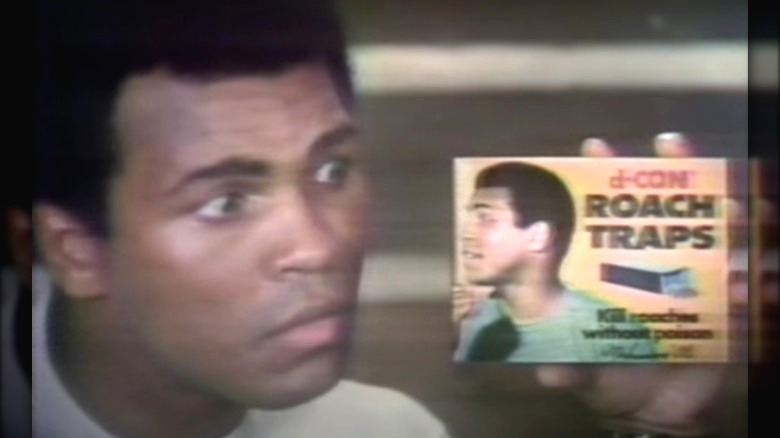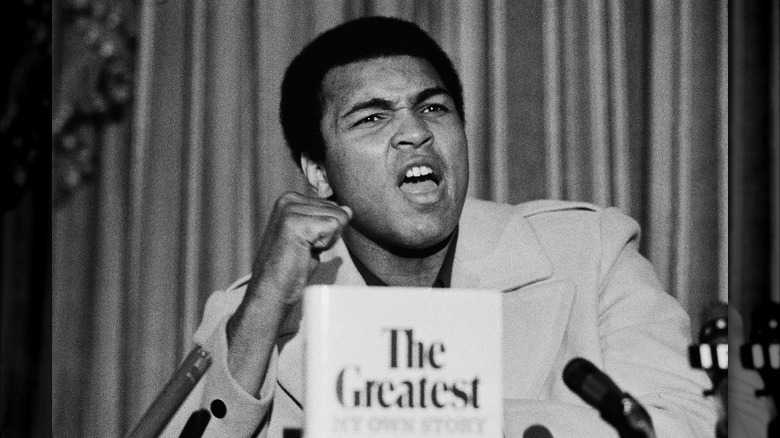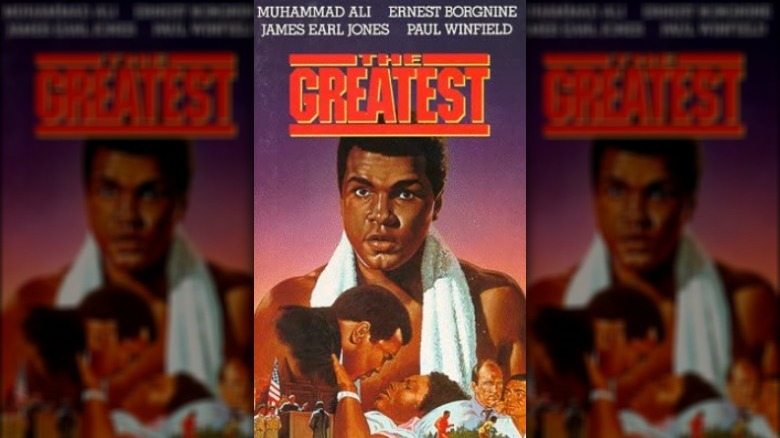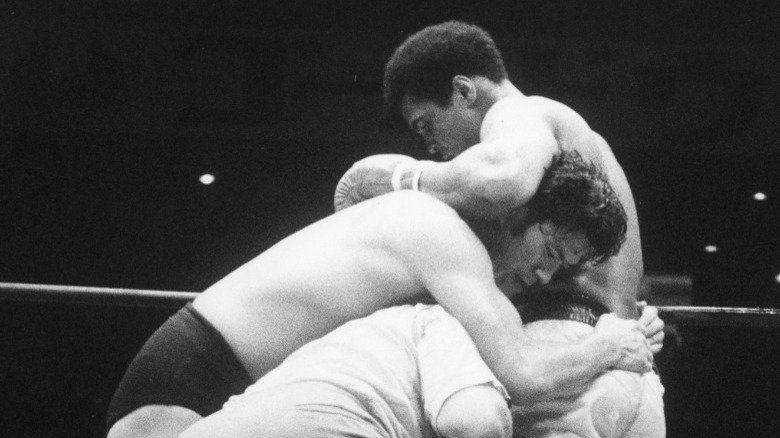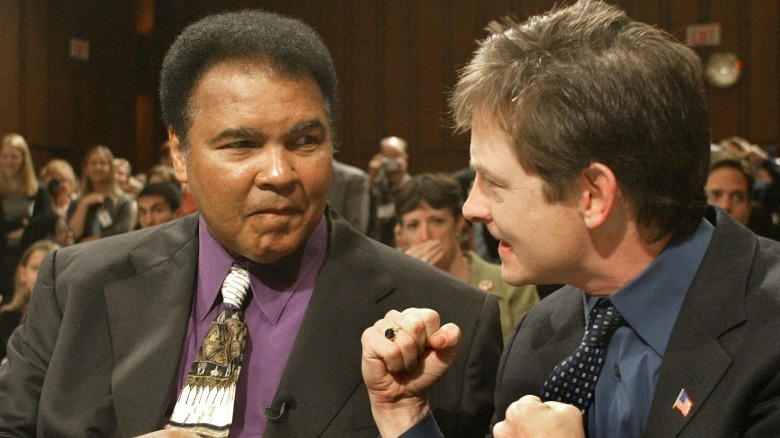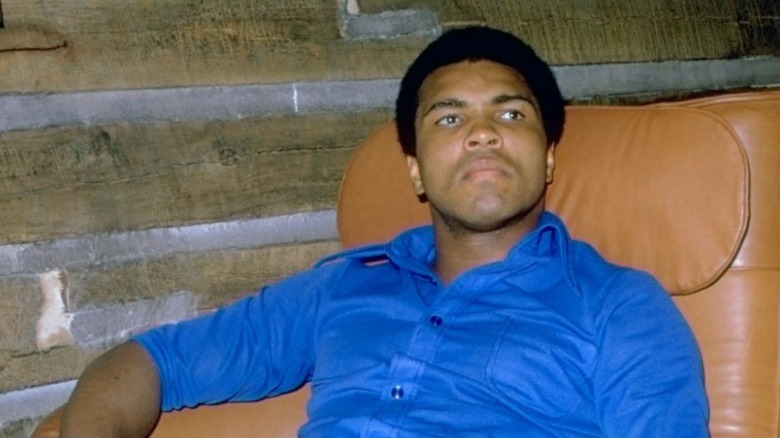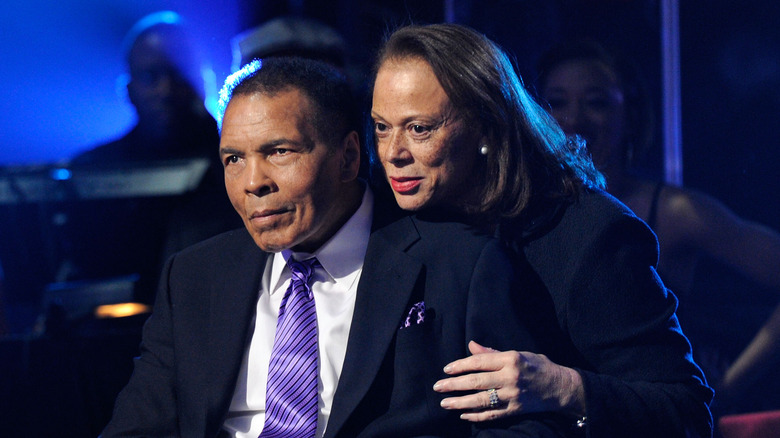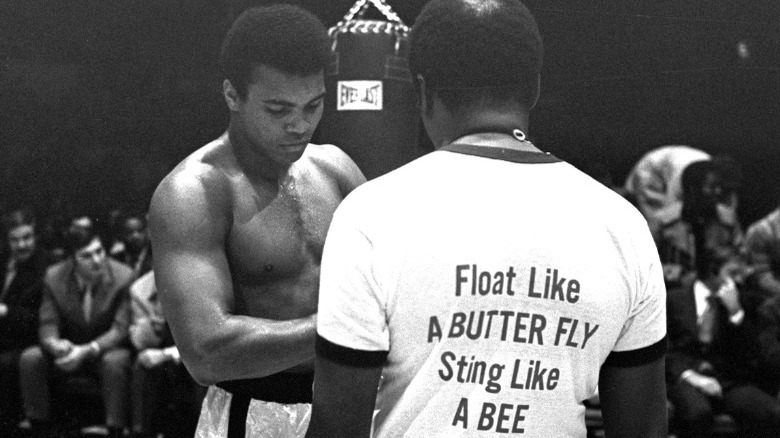How Much Was Muhammad Ali Worth When He Died?
Muhammad Ali is regarded as the greatest boxer of all time. He made millions from some of the most watched boxing matches in history, and in his prime, as National Hall of Fame Sportswriter Dave Kindred once recalled (via Team USA), "He was the most famous man in the world. Literally, the surveys always had him and the Pope running 1-2. Sometimes Ali would be No. 1 and sometimes the Pope would be No. 1."
Ali had his fair share of financial ups and downs, in part because he never put making money before sticking true to his strong personal beliefs. In an interview with Michael Parkinson, he explained, "When one man of popularity can let the world know the problem, he might lose a few dollars himself telling the truth, might lose his life, but he's helping millions. But if I kept my mouth shut just because I can make millions, then this ain't doing nothing."
Luckily for Ali, he still made millions despite his outspoken nature. In fact, at the time of his death in 2016, the famous boxer's net worth was an impressive $50 million, according to Celebrity Net Worth. Let's take a look at exactly how Muhammad Ali got to that amount.
How Muhammad Ali found his way to fighting
Muhammad Ali was born Cassius Clay and grew up in the segregated South in a working class neighborhood of Louisville, Kentucky. His mother cleaned homes for a living and his father was a sign painter.
Early on, the future boxing champ saw the injustice of segregation and recognized how it had held his family back financially. In the 2021 PBS docuseries, "Muhammad Ali," journalist Jonathan Eig explains, "[He] would ask his father, 'Why can't I be rich?' And his father would just point to the color of his skin and say, 'That's why you can't be rich.'" When Ali was 12, someone stole his bicycle, and he reported it to a police officer, angrily proclaiming he was going to find the thief and beat him up. The officer, Joe Martin, happened to train young men in boxing, and seeing a rage that could be channeled into something productive, taught Ali how to fight.
After an impressive amateur career that included winning the gold medal for light heavyweight boxing at the 1960 Olympics in Rome at the age of 18, the boxer still known as Cassius Clay began to box professionally. That same year, he fought and won his first professional match in his hometown against Tunney Hunsaker. According to ESPN, he made $2,000 from the fight, which in today's dollars would be more like walking away with $18,000. Shortly after, Ali signed with a management group in Louisville composed of local businessmen for $18,000 (or, $166,000 in modern money).
Muhammad Ali's rise to fame
Even as a young boxer, Muhammad Ali told the world he was "The Greatest." His bragging earned him another nickname: "The Louisville Lip." But he certainly lived up to his own hype and shocked many when he defeated Sonny Liston to become the heavyweight champion of the world at the age of 22 in 1964.
Before the fight, Ali appeared on the cover of Sports Illustrated sitting on stacks of money (pictured above) and said, "That's how much money my fists and my mouth will have earned by the time my fight with Liston is over. Think about that. A southern colored boy has made $1 million just as he turns 22. I don't think it's bragging to say I'm something a little special."
Shortly after his big win, Cassius Clay changed his name to Muhammad Ali and announced his membership in the Black religious organization, Nation of Islam. He defended his heavyweight champion title nine times from 1964 to 1967, earning hoards of cash. Unfortunately, Ali never saw much of the money, saying in an interview with PBS, "I had nine title fights and out of those nine big title fights, my cut was 2 million dollars. ... And out of the $2 million, the 10 white men that backed me in Louisville, they made a deal with the government behind my back ... they would give the government 90% of all my earnings before I got them. ... So that only left me 10% out of $2 million to live on."
He was prevented from working for years
At the height of his fame and fortune, Muhammad Ali nearly lost everything. In 1967, he was drafted to fight in the Vietnam War, but refused for political and religious reasons. Per History, he was subsequently stripped of his heavyweight champion title, forbidden to work in the United States, fined $10,000, and received a 5-year jail sentence (which was ultimately overturned).
In a 1968 interview, the boxer admitted he was "just about broke" and explained, "White America has completely closed all the doors on me. I'm not allowed to work in America. I was stopped right in my prime just when I started making money." But Ali confessed that he willingly gave up the money to stay true to his principles and beliefs, stating, "Tomorrow I could go back to get the money if I would only deny my faith, if I would only join up against my religion, I could easily go back to making millions. So I can always say that I turned this down; I didn't lose it, I turned it down, and I go out still with my head high."
During these years in exile, Ali was invited to speak at colleges, reportedly earning $1,500 a speech (via the New York Post). However, he predominantly served as a Muslim minister and claimed he would only return to boxing to get out of debt. Angelo Dundee, his trainer, later told ESPN, "Due to his beliefs, he was robbed of the best years of his life."
The fantasy fight that brought in cash during Muhammad Ali's exile
During Muhammad Ali's years of exile, another odd source of income came from a fantasy fight. In 1968, Murray Woroner, a Miami advertising executive, created a simulated boxing tournament to see how some of the greats throughout history would have fought against one another, per The Guardian. The results were determined by a computer that was able to analyze the different fighting techniques of various famous boxers, including Ali. The results claimed that Ali would have lost to Jim Jeffries, a claim that Ali was not too happy about.
Ali cried defamation and sued Woroner for $1 million. While he didn't get the million, the matter was settled with Woroner paying Ali $10,000 in 1969 to film the results of the computer-generated fight with boxing legend Rocky Marciano, dubbed "The Super Fight." Ali was desperate for cash and wrote in his autobiography (via The Guardian), "I was in the deep-freeze part of my exile and there was no thaw in sight."
The film was released in select theaters in 1970 and grossed $5 million.
The great comeback of 'The Greatest'
In 1970, Muhammad Ali was allowed to return to boxing. That year, he made over a million bucks in the ring from just two matches. In 1971, his fight against Joe Frazier, labeled "The Fight of the Century," brought in $2.5 million for Ali — despite the fact that he lost. At the time, this was one of the highest-grossing boxing matches in history. In 1974, his match against George Foreman — called "Rumble in the Jungle" — beat that number by bringing in $5.4 million for Ali, which remains his highest-grossing fight ever when adjusted for inflation (that amount is more like $29.2 million in today's dollars), though his $6 million paycheck for his fight against Ken Norton equals close to the same amount.
"That's right, I am the true Six Million Dollar Man in money, genius, personality, charisma. The whole world's coming to see this fight," Ali boasted to The New York Times in 1976. Indeed, his fights during this era were watched by billions of people worldwide and were the largest contributors to his fortune at the time. Previously, in 1972, he made The Guinness Book of World Records for accumulating the largest fortune in boxing.
Ali retired from boxing in 1981 after his health began to take a turn for the worse, but the '70s were certainly his most lucrative years, with "The Greatest" fighting in 30 fights that averaged well over a million per fight.
Muhammad Ali's divorces cost him millions
Muhammad Ali was married four times and went through three divorces, per USA Today. His first marriage to Sonji Roy lasted only 17 months. "I had to pay $150,000 to get rid of my first wife 'cause she wouldn't join my faith," he stated in a 1968 interview. In 1967, the boxer married his second wife, Khalilah, with whom he had four children. Ali, however, allegedly had a number of affairs during their 10-year marriage, and they divorced in 1976 due to the infidelity. The settlement cost him $2 million.
It didn't take long for Ali to marry again. In 1977, he tied the knot with Veronica Porché (pictured above). Their marriage produced two children and lasted nearly a decade until they divorced in 1986, again due to infidelity, and she reportedly "ended up with the house, the art collection and maybe half of a $2 million bond portfolio" (via Wealth Advisor). According to People, he also paid $100,000 a year in child support for a time to both Khalilah and Veronica.
In 1986, shortly after his divorce from Veronica, Ali married Lonnie Williams, whom he had known since she was a child, and she would remain by his side until his death in 2016.
He hit financial lows and bad investments
Throughout his life, Muhammad Ali was routinely low in funds and periodically in debt. Considering he was one of the highest-paid boxers ever, it's hard to imagine Ali running out of money. Indeed, as financial advisor Mark McCormack told People in 1980, "The man has earned $60 or $70 million in the ring. With proper management, that kind of money should have him set to live in luxury for the rest of his life."
So where did the millions go? Large sums seemingly disappeared into poor business investments. In his book, "Running with the Champ," friend Tim Shanahan explains, "Throughout his career, the investment advice Muhammad had received had mostly resulted in disasters." Those flops included a chain of restaurants called Champburger and a soda brand called Mr. Champ. According to Shanahan, Ali "licens[ed] his name to all kinds of odd products that would turn out to be low quality or otherwise unmarketable." What's worse, these questionable businesses generated "round after round of litigation," requiring exorbitant legal fees.
When USA Today asked his wife, Lonnie, if she had been "surprised at Muhammad's financial condition after he retired," she responded, "I was somewhat stunned. I thought he should have been better off. ... Muhammad is not a businessperson. Muhammad did what he wanted to do. That is the nature of the man; that is how he got to be who he is."
Muhammad Ali wasn't always big on endorsements
As famous as he was in his heyday, Muhammad Ali didn't have that many endorsement deals. This was somewhat a result of an era where few endorsement opportunities existed for sports stars, particularly boxers. Besides a series of commercials for cockroach-killing products he appeared in during the late 1970s, his career was lacking in big money-making advertisements until after his retirement. And even then, Ali's Parkinson's disease diagnosis gradually limited his ability to make appearances as a spokesperson for brands.
Still, though Ali could no longer step into the ring, an array of post-retirement advertising appearances and licensing deals definitely helped bulk up his fortune. In fact, his licensing company GOAT (which stands for Greatest of All Time) was his primary source of income for the rest of his life. In 2006, Ali sold 80% of GOAT, thus the rights to his name and image, for $50 million, per CNN Money. The 20% stake he retained continued to generate a yearly income for him.
Ali said of the deal, "[It will] help guarantee that, for generations to come, people of all nations will understand my beliefs and my purpose."
He landed book deals and record deals
Some claim Muhammad Ali was "the first rapper," per The Guardian — and there is no doubt that his words had a lasting influence on hip hop. The athlete's first spoken-word album, titled "I Am the Greatest," dropped in 1963 on Columbia Records in a reportedly $25,000 deal. The album's release coincided with his championship match against Sonny Liston. According to The Undefeated, "The morning after the fight, factories were 'swept clean' as soon as phone lines opened. The album had hit a mark of 30,000 records, but the post-fight craze propelled it toward the 500,000 gold plateau." The album was nominated for a Grammy for best comedy performance.
By 1975, Ali had moved onto writing instead of speaking his words, inking a Random House book deal for an autobiography titled "The Greatest." The heavyweight champion received a $200,000 advance, according to Jonathan Eig's biography, "Ali: A Life." Then came another spoken-word album in 1976. This time, it was an odd PSA album targeted toward children titled "The Adventures of Ali and His Gang vs. Mr. Tooth Decay." The album featured other stars like Frank Sinatra in what was seemingly a complicated commercial for St. John's Fruit and Vegetable Company endorsed by The American Dental Association. How much Ali made in this deal is unclear, though his participation did bring him his second Grammy nomination, this time for best recording for children.
In 2003, Ali released another book, "The Soul of a Butterfly," which would have garnered additional post-retirement income.
Muhammad Ali caught the acting bug
Muhammad Ali created a larger-than-life persona and character for himself both in and out of the ring, so it's no surprise that the boxer also dabbled in acting. Throughout his career, he made several guest appearances on television shows and sitcoms, including "Diff'rent Strokes," usually playing himself. But he proved he could act in a serious role and do it well when he appeared on Broadway as the title character in the musical "Buck White" during his exile years. The producer of the show, Zev Buffman, told The New York Times, "Ali was brilliant. ... I have never seen anyone or anything like it, the way he captured the stage with a charisma that got people on their feet for five straight minutes."
His most prominent role was appropriately playing himself in the 1977 biopic, "The Greatest," based on his autobiography of the same name. The film grossed $3.8 million.
Inside this boxer's brief professional wrestling stint
Muhammad Ali's connection to professional wrestling ran deep. The bragging, over-confident, "I'm pretty" affectation that Ali perfected was heavily influenced by professional wrestler Gorgeous George, and Ali always took an interest in wrestling.
In 1975, he orchestrated a fight with professional Japanese wrestler Antonio Inoki, per the Los Angeles Times. When Ali agreed to the fight and a $6 million paycheck, he was under the mistaken impression that it was going to be an easy scripted event. After arriving in Japan, his management worked quickly to change the rules to restrict what Inoki was allowed to do in the ring.
The match was an odd mixed martial arts display where Inoki spent most of the time on his back on the ground, kicking at Ali. Though the fight brought in a large amount of money for Ali, it also caused some serious injuries for both men. Ali left the ring with a bleeding, swollen leg that led to two blood clots. Inoki had broken his foot kicking Ali. The circumstances resulted in Inoki filing a lawsuit for $743,333 because "Inoki had suffered a loss of revenue resulting from his performance in the widely publicized match" (via The New York Times). While Ali went back to America with his $6 million, Inoki claimed to have never been paid his promised $2 million. The whole matter was eventually resolved, and the two men became friends.
In 1985, Ali refereed at WrestleMania in Madison Square Garden.
Muhammad Ali and his philanthropic endeavors
Though he claimed to be "so mean" he made "medicine sick" (via Reuters), Muhammad Ali was actually a genuine and caring person to those around him. He never hesitated to give away money to friends, family, and strangers. In the book, "Running with the Champ," his friend, Tim Shanahan wrote, "He had a tremendous desire to take care of people and to solve problems, and if his fame and money could solve other people's problems — so be it."
Ali once said, "I've always wanted to be more than just a boxer. ... I wanted to use my fame, and this face that everyone knows so well, to help uplift and inspire people around the world. I've made my share of mistakes along the way but if I have changed even one life for the better, I haven't lived in vain" (via CNN). He certainly changed more than one life for the better with his wealth and influence. For instance, in 1990, he negotiated with Saddam Hussein and succeeded at bringing home 15 American hostages. According to the National Constitution Center, who awarded Ali the Liberty Medal in 2012, he also "visited countless soup kitchens and hospitals and helped organizations including the Make-A-Wish-Foundation and the Special Olympics." In 2005, he was awarded the Presidential Medal of Freedom for his humanitarian work.
As a result of his friendship with actor and Parkinson's disease activist Michael J. Fox, Ali also made countless contributions to fund research to cure the same disease he had.
His lucrative real estate investments
As expected, the multi-millionaire boxer owned several properties throughout his life, most that weren't sold until after his death. Muhammad Ali purchased 81 acres of farmland in Michigan in 1975 for $400,000 and built a home on the property. The home sold for $2.5 million in 2018 to the Türken Foundation, which, as of 2019, made plans to turn the former secluded hideaway into a summer school for Muslim students. "This will also be a chance for students to be inspired by Ali's life philosophy and work for success. It will obviously be beneficial to the Muslim community in the United States to use this property for this specific purpose," said the president of the foundation (via Daily Sabah).
In the early 1970s, Ali bought a property in Pennsylvania to use as a training camp. According to NY Fights, "He paid $520,000 for the facility and spent at least $650,000 on renovations." Ali sold the property in 1997 to martial arts instructor George Dillman. Dillman sold the property to NFL coach John Madden's son, Mike Madden, for an undisclosed amount. In 1979, Ali also purchased a Los Angeles mansion that sold for $17 million in 2019 (via Town & Country).
In 2005, Ali and his wife, Lonnie, purchased a home in Phoenix, Arizona. The couple reportedly bought it with $1.6 million in cash (via AZcentral). In 2006, they also purchased a 9,300 square foot house in their hometown of Louisville, Kentucky for $1.875 million, which sold for $2.2 million in 2016.
Muhammad Ali's will revealed family drama
Muhammad Ali died in June 2016 at the age of 74, per BBC News. According to reports of his will, each one of his nine acknowledged children allegedly inherited $6 million from his estate after his death. His wife, Lonnie, reportedly earned double the amount of the children at $12 million, per Wealth Advisor.
Ali's only sibling, brother Rahman, was left out of the will, and it was reported this was due to Rahman having a fallout with Lonnie. Muhammad Ali's son, Muhammad Ali Jr., told the Mirror, "Rahman is really hurt because Lonnie didn't invite him to the family part of the funeral. He was meant to be at the hospital, but she didn't tell him about that." It became evident that much of the Ali family had possibly been at odds with the boxer's fourth wife.
While an anonymous insider spoke to the Mirror and claimed the will could cause "World War 3" amongst the family, Wealth Advisor reported that the will could actually be viewed as well thought-out and pretty fair when considering all aspects. For example, the children likely received the money from some of Ali's older properties that he had purchased before marrying Lonnie.
Meanwhile, his daughter, May May Ali, has denied all allegations of the family dispute and said that reports of the will were false. "We're not millionaires from our inheritance," she contested on Sway's Universe in 2019.
The lasting legacy of the boxing legend
Following Muhammad Ali's death in 2016, nearly a billion people watched his funeral — and the loss of his one-of-a-kind personality was felt worldwide. Meanwhile, the boxer's legacy would continue to bring in money for his estate through licensing, as well as the selling of his properties and assets. For example, in 2021, some of the drawings and paintings Ali had created sold for almost $1 million at auction. As the executive creative director of Baker Street Advertising, Bob Dorfman, stated (via NBC News), "His name and likeness will continue to be a highly valuable commodity for many years to come."
Ali certainly carved his place in history and will always be remembered as one of the most influential people of the 20th century. But he once simply stated he hoped to be remembered "as a man who never sold out his people" (via BBC News). However, Muhammad Ali added, "But if that's too much, then just a good boxer. I won't even mind if you don't mention how pretty I was."

